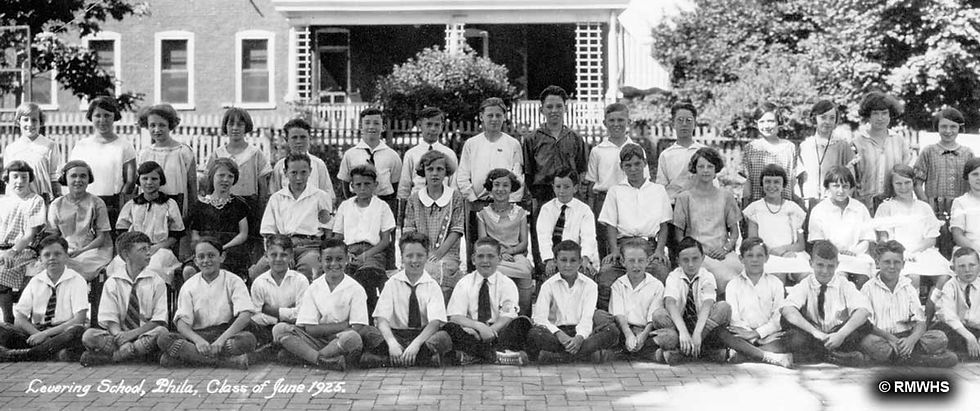Preserving & Promoting
Local History, Art, & Culture




Ridge Ave Roxborough Historic District
Turn of the Century
Although the Roxborough Railroad failed to provide access to the rural sections of Roxborough for suburban development, the construction of the Walnut Lane Bridge over the Wissahickon in 1907 and 1908 did better connect Roxborough to Germantown and open the way for development of the open land overlooking the valley (Figure 38). Until the bridge opened at the dawn of the automobile era in 1908, traveling between Germantown and Roxborough required the steep descent into the gorge and the equally steep climb out of it, an extremely difficult task in the era of horse-drawn carriages and wagons. Constructed by engineers of the City of Philadelphia, the concrete arch bridge, the longest single-span masonry arch in the world when completed, was considered an engineering marvel.109
While the Walnut Lane Bridge offered a convenient connection to Germantown, Roxborough’s boosters still wanted a direct connection to burgeoning North Philadelphia and to the downtown beyond that did not require negotiating the steep hill up the Ridge from the Schuylkill or the deep Wissahickon gorge. The Henry Avenue Bridge, which carries Henry Avenue over the Wissahickon and Lincoln Drive, was contemplated as early as 1912 as part of a subway extension plan, but was not implemented for nearly two decades. By the time it was implemented, the automobile had supplanted all other forms of transportation. After many years of planning and false starts, the bridge was designed by prominent engineers Ralph Modjeski and Frank Masters in collaboration with renowned architect Paul Cret in 1927, constructed in the early 1930s, and completed in May 1932. At the same time, Henry Avenue was extended from East Falls, across the Wissahickon, and through Roxborough to Ridge Avenue in the Andorra section. The wide, four-lane boulevard, which runs along the western boundary of the Wissahickon section of Fairmount Park, was designed for automobiles, not horses or trolleys, and opened the remainder of Roxborough for suburban development. Although the mass transit facilities were built into the bridge, no transit line was run along Henry Avenue and the bridge’s transit facilities were never used. Even before the bridge was completed, real estate agents were marketing suburban homes along Henry Avenue. For example, in 1927 real estate agents Mason & Bruhns advertised an “exceptional home ‘In the Open Suburbs of Philadelphia,’ 613 Walnut Lane at Henry avenue, adjoining the Wissahickon Valley and proposed golf course. New Henry Avenue Bridge will enhance value.”110
 Describe your image |
|---|
In 1907, while the Walnut Lane Bridge was under construction, Fowler & Kelly published an aerial view of Roxborough from West Laurel Hill Cemetery drawn by Thaddeus Mortimer Fowler (Figure 39). The bird’s-eye, which includes the incomplete Walnut Lane Bridge, depicts Roxborough, with its dense suburban development in Wissahickon and Leverington and its open rural land to the north and east, in its final moments before the automobile would forever alter development patterns and the built environment in the lower northwest section of the city.
 Describe your image |
|---|
Figure 39. Thaddeus Mortimer, Birds Eye View of Manayunk, Wissahickon-Roxborough from West Laurel Hill Cemetery, Philadelphia, Pennsylvania 1907, published by Fowler & Kelly, Morrisville, Pa., 1907.
This information has been posted by RMWHS with the permission of the Philadelphia Historical Commission.
Sections:
109 Contemporary accounts of the Walnut Lane Bridge also include “The Walnut Lane Bridge Across the Wissahickon Valley,” The Press, 27 April 1907; “Bridge Over the Wissahickon Creek and Its Main Span,” Public Ledger, 11 July 1907; “Bridge False Work Collapses; One Dead,” Public Ledger, 28 December 1907. On the design and construction, see George S. Webster, “Annual Report of the Board of Surveys,” in Second Annual Message of John E. Reyburn, Mayor of the City of Philadelphia ... for the Ending December 31, 1908 (Philadelphia, 1909), II, 328-329; George S. Webster and Henry H. Quimby, “Walnut Lane Bridge, Philadelphia,” Transactions of the American Society of Civil Engineers 35, no. 6 (August 1909): 587-625; “The Walnut Lane Bridge, Philadelphia,” Engineering Record 54, no. 20 (17 November 1906): 542-544; “Moving the Centering of the Walnut Lane Arch at Philadelphia,” Engineering News 58, no. 7 (15 August 1907): 168; “The Walnut Lane Bridge, Fairmount Park, Philadelphia,” Engineering Record 56, no. 9 (31 August 1907): 222-226; J.A. Stewart, “The New Bridge Over the Wissahickon at Philadelphia,” Scientific American 97, no. 22 (30 November 1907): 392-393; George Maurice Heller, “The Design of the Centering for the 233-Ft. Arch Span, Walnut Lane Bridge, Phila., Pa.,” Proceedings of the Engineers’ Club of Philadelphia 25, no. 3 (July 1908): 257-278; “The Effect of Temperature on the Walnut Lane Concrete Arch,” Engineering News 62, no. 15 (7 October 1909): 376; “Walnut-Lane Bridge, Philadelphia, Pa.,” The Builder 98, no. 3516 (25 June 1910): 727-730; “The Largest Single-Span Concrete Bridge in the World,” World To-Day 15 (December 1908): 1293; Frederic Blount Warren, “The Walnut Lane, Philadelphia, Bridge: A Majestic Concrete Structure,” Scientific American Supplement 66, no. 1715 (14 November 1908): 306.
110 Inquirer, 27 November 1927, p. 69.